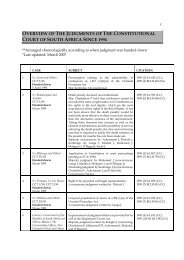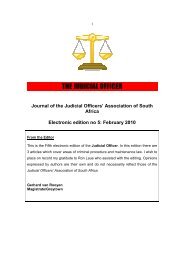The Judical Officer - Dec 07 - Joasa.org.za
The Judical Officer - Dec 07 - Joasa.org.za
The Judical Officer - Dec 07 - Joasa.org.za
Create successful ePaper yourself
Turn your PDF publications into a flip-book with our unique Google optimized e-Paper software.
24<br />
* between groups of individuals (Albertyn & Kentridge 1994:152-153; De<br />
Waal et al 1999: 190-191; Van Reenen 1997: 153).<br />
For example, formal equality is achieved if all children, including deaf children, are<br />
educated according to the same school curriculum (De Waal et al 1999:190).<br />
Both Albertyn & Kentridge (1994) and Van Reenen (1997) emphasize substantive substantive<br />
equality in stead of formal equality.<br />
8.1.2 Substantive Substantive equality<br />
Substantive equality demands that the law must ensure equality equality of outcome for<br />
individuals, taking into account these individuals’ circumstances. Why ? Because<br />
substantive equality demands demands an analysis of the true economic and social disparities<br />
* between individuals; and<br />
* between groups of individuals (Albertyn & Kentridge 1994:152-153; De Waal et al<br />
1999:190-191; Van Reenen 1997:153).<br />
For example, substantive equality demands that the law must ensure equality of<br />
outcome for individuals, but, if deaf children are educated according to the same school<br />
curriculum as “normal” children (as according to formal equality), then it is<br />
very likely that these deaf children are receiving an education which is inadequate for<br />
their special needs (De Waal et al 1999:190).<br />
<strong>The</strong> implication appears to be the following:<br />
To realize the right of equality of these deaf children, it may be necessary to treat<br />
these deaf children different than normal children (De Waal et al 1999:190).




